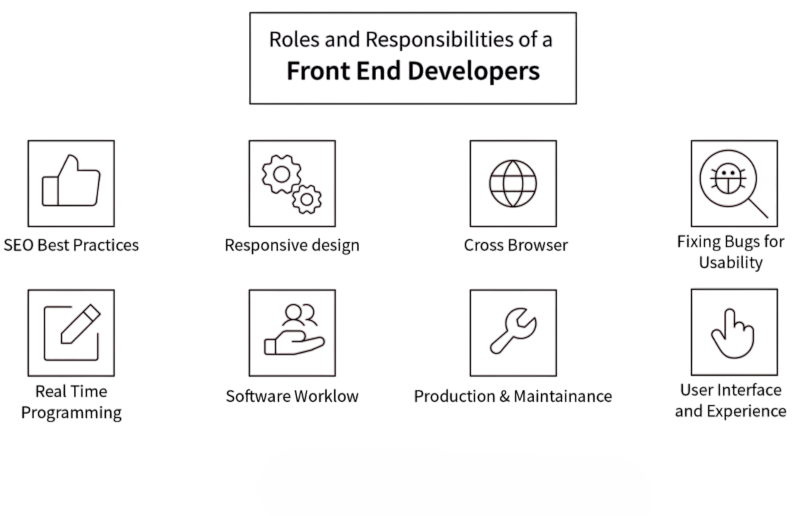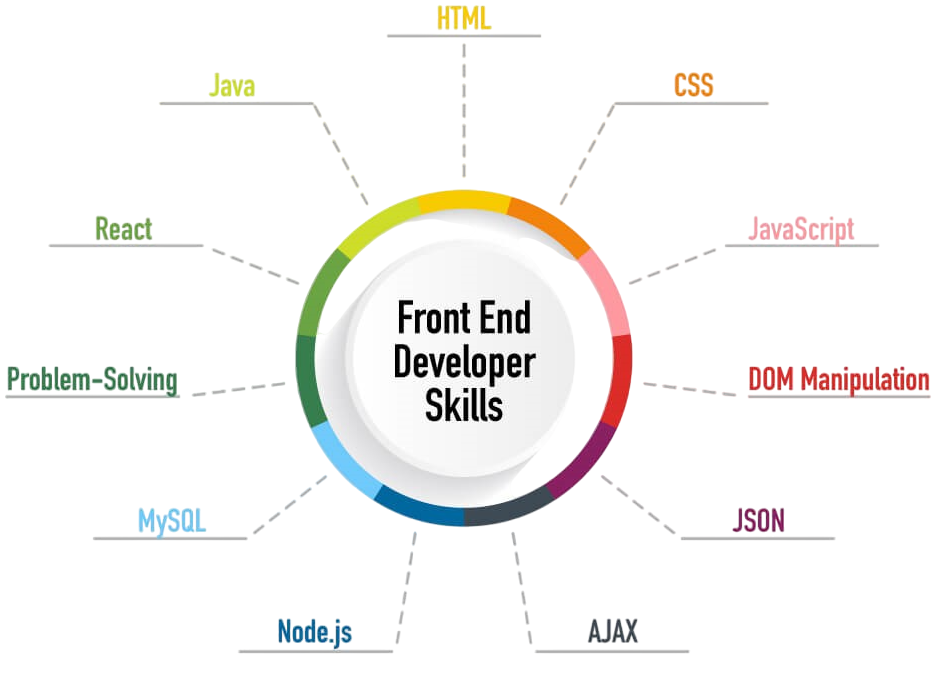
- Front End Development
- Role and Responsibilities
- Key Skills Required
- Technologies Used (HTML, CSS, JS)
- Frameworks and Libraries (React, Angular, Vue)
- Responsive Design and UX
- Tools and IDEs
- Collaboration with Backend Developers
- Version Control (Git, GitHub)
- Conclusion
Front End Development
Front end development is a critical aspect of web development that focuses on creating the visual and interactive components of a website or web application. It encompasses everything users see and interact with in their browsers. The main goal of front end development is to ensure a seamless, engaging, and accessible user experience an objective emphasized in Web Designing Training, where learners master HTML, CSS, JavaScript, and responsive design principles to build intuitive interfaces. By focusing on usability, performance, and cross-device compatibility, front-end developers create digital experiences that delight users and drive retention. With the growing importance of digital platforms, the demand for skilled front end developers has skyrocketed. Front end development acts as the bridge between design and technology. Developers take the visual designs provided by UI/UX designers and convert them into functional code using HTML, CSS, and JavaScript. It involves not only technical knowledge but also a strong sense of aesthetics and user behavior. This field requires professionals to be detail-oriented, creative, and adaptive to rapidly evolving technologies.
To Earn Your Web Developer Certification, Gain Insights From Leading Data Science Experts And Advance Your Career With ACTE’s Web Developer Courses Today!
Role and Responsibilities
A front end developer acts as an important link between design and functionality. They turn visual ideas into interactive digital experiences an essential role explored in Become an Angular Developer, where learners master component-based architecture, responsive UI design, and TypeScript-driven logic. Angular’s framework empowers developers to translate creative concepts into scalable, high-performance applications that deliver seamless user experiences across devices. By translating design mockups into clean, responsive code with HTML, CSS, and JavaScript, they make sure websites are visually appealing and easily accessible on desktops, tablets, and smartphones.

Their job goes beyond coding; it includes improving performance, ensuring compatibility across different browsers, and carefully implementing interactive features like animations and forms. Front end developers work closely with UI/UX designers, backend developers, and project managers. They play a key role in creating cohesive, high-performing digital products. Through careful testing and debugging, they ensure that user experiences are consistent on various platforms. This ultimately leads to web interfaces that are both technically solid and visually attractive.
Key Skills Required
To excel in front end development, a combination of technical and soft skills is essential:
- HTML/CSS: Strong foundation in structuring content (HTML) and styling elements (CSS).
- JavaScript: Mastery of core JavaScript concepts like variables, loops, functions, DOM manipulation, and event handling.
- Responsive Design: Ability to create layouts that adapt to different screen sizes.
- Version Control Systems: Familiarity with Git and GitHub for code management and collaboration.
- Problem Solving: Analytical skills to debug issues and implement logical solutions.
- Communication Skills: Ability to articulate ideas and collaborate effectively with cross-functional teams.
- Attention to Detail: Precision in translating designs and maintaining consistency in styling and layout.
- HTML (HyperText Markup Language): The backbone of web content, HTML provides the structure of web pages. It includes elements like headings, paragraphs, images, links, and more.
- CSS (Cascading Style Sheets): CSS is used to style and layout HTML content. It controls aspects like fonts, colors, spacing, positioning, and animations. Modern CSS features include Flexbox, Grid, and media queries.
- JavaScript: The scripting language that adds interactivity to web pages. JavaScript can handle events, manipulate the DOM, fetch data from APIs, and update the UI dynamically. ES6+ versions have introduced features like arrow functions, classes, modules, and promises.
- IDEs and Code Editors: VS Code, Sublime Text, Atom.
- Browser DevTools: Built-in tools in Chrome, Firefox, etc., for inspecting elements, debugging JavaScript, and monitoring network activity.
- CSS Preprocessors: SASS, LESS for writing more maintainable and modular CSS.
- Build Tools: Webpack, Gulp for bundling assets and optimizing performance.
- Package Managers: npm, Yarn for managing dependencies.
- Design Tools: Figma, Sketch, Adobe XD for collaborating with designers.
- Understanding APIs: Consuming RESTful or GraphQL APIs to fetch and display data.
- Data Validation: Ensuring front end form validation complements backend logic.
- Authentication and Authorization: Implementing login systems and role-based access.
- Continuous Integration: Syncing development efforts using shared repositories and CI/CD pipelines.
- Clear Documentation: Sharing API contracts and data formats to avoid integration issues.

Would You Like to Know More About Web Developer? Sign Up For Our Web Developer Courses Now!
Technologies Used (HTML, CSS, JavaScript)
Frameworks and Libraries (React, Angular, Vue)
Front-end development has changed with the rise of powerful frameworks and libraries that greatly improve web application creation. React, developed by Facebook, is a standout component-based library that uses a virtual DOM for efficient rendering. This allows developers to build dynamic user interfaces with effective state management—an essential capability taught in Web Designing Training, where learners explore how tools like React, Redux, and Context API enable responsive, scalable, and maintainable applications. By mastering local and global state techniques, developers ensure seamless user experiences across complex workflows and interactive components. Angular, created by Google, offers strong tools for building complex Single Page Applications using TypeScript, two-way data binding, and advanced dependency injection. Vue provides a modern alternative, skillfully merging the strengths of React and Angular while staying lightweight and accessible for projects of different sizes. Together, these frameworks change development processes by greatly improving code reusability, maintainability, and scalability. This speeds up project timelines and gives developers effective, standardized approaches, frameworks and libraries to simplify the creation of complex web applications.
Are You Interested in Learning More About Web Developer? Sign Up For Our Web Developer Courses Today!
Responsive Design and UX
In today’s digital world, responsive design is a key strategy for creating great web experiences on different devices and screen sizes. By using flexible grids, media queries, and scalable assets, websites can easily adjust to smartphones, tablets, and desktops while focusing on user experience. The main idea of responsive design is a mobile-first approach. Developers start by designing for smaller screens and then improve the design for larger displays an essential concept covered in 10 Reasons to Learn JavaScript, where learners discover how JavaScript powers adaptive layouts, dynamic content rendering, and device-specific interactions. Mastering these techniques enables developers to build seamless experiences across smartphones, tablets, and desktops. This method is supported by fluid grid systems and responsive media that change layout and content as needed, ensuring visual consistency and easy reading. Additionally, responsive design includes more than just technical aspects; it highlights simple navigation, touch-friendly interactions, and strong accessibility features. By using semantic HTML and ARIA attributes, web designers can create digital spaces that support users with different abilities, ultimately offering a more engaging and user-focused online experience that meets the varied needs of today’s digital consumers.
Tools and IDEs
Front end developers utilize various tools to streamline coding, testing, and collaboration an ecosystem explored in What is React, where frameworks like Storybook support UI development, Jest enables robust testing, and Git-based workflows enhance team coordination. React’s component-driven architecture pairs seamlessly with these tools, empowering developers to build scalable, maintainable, and high-performing applications with confidence.
Collaboration with Backend Developers
A seamless collaboration between front end and backend developers is vital for project success. Front end developers rely on backend services for data via APIs, and backend developers depend on front end interfaces to visualize functionality. Collaboration involves clear API contracts, shared documentation, and synchronized deployment cycles practices that differ in AngularJS Vs JQuery, where Angular promotes structured MVC architecture and dependency injection, while jQuery focuses on lightweight DOM manipulation. Understanding these paradigms helps teams align workflows, reduce integration friction, and build scalable, maintainable applications.
Version Control (Git, GitHub)
Version control is a vital part of modern software development. Git has become the standard system that helps developers track, manage, and collaborate on code. Using platforms like GitHub, teams can host repositories, perform code reviews, and improve project workflows with features like pull requests and issue tracking. Following best practices such as writing clear commit messages, using consistent branching strategies like Git Flow, and holding regular code reviews helps development teams keep their processes high-quality, clear, and efficient principles reinforced in What is Angular, where semantic commit conventions and modular architecture promote maintainability and collaboration. Angular’s structured approach encourages disciplined workflows, version control hygiene, and scalable development practices across teams. This method boosts collaboration and creates a strong system for tracking changes, managing releases, and preserving the integrity of complex software projects.
Conclusion
Front end development is a dynamic and essential domain in the tech industry, combining creativity, logic, and user empathy. It plays a pivotal role in shaping how users interact with digital platforms. As technologies and user expectations evolve, so must front end developers by continuously learning new tools, improving performance, and enhancing accessibility core principles emphasized in Web Designing Training, where learners explore modern frameworks, performance optimization techniques, and inclusive design standards. Staying current with trends like responsive architecture, semantic HTML, and WCAG compliance ensures developers build interfaces that are fast, flexible, and accessible to all users. For those passionate about building engaging user experiences, a career in front end development offers both intellectual fulfillment and professional growth.



